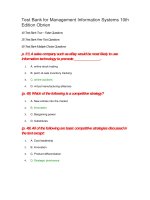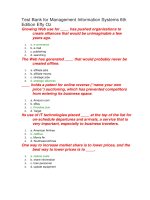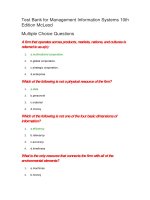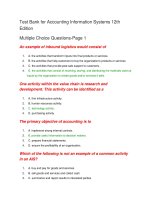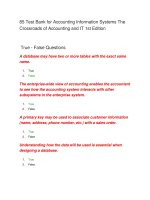Test bank for accounting information systems 1st edition by richardson
Bạn đang xem bản rút gọn của tài liệu. Xem và tải ngay bản đầy đủ của tài liệu tại đây (570.6 KB, 46 trang )
Download full Test Bank for Accounting Information Systems 1st
Edition by Richardson At
/>
Chapter 01
Accounting Information Systems and Firm Value
True / False Questions
1. Accounting and Finance is a primary activity in the value chain.
True
False
2. Accounting Information Systems at this date are all computerized.
True
False
3. Business value includes all those items, events and interactions that determine the financial
health and well-being of the firm.
True
False
4. The Certified Information Technology Professional (CITP) is a professional designation for those
with broad range of technology knowledge and does not require a CPA.
True
False
1-1
Copyright © 2014 McGraw-Hill Education. All rights reserved. No reproduction or distribution without the prior written consent of
McGraw-Hill Education.
5. The Certified Information Systems Auditor (CISA) is a professional designation generally sought
by those performing IT audits.
True
False
6. Information is defined as being data organized in a meaningful way to be useful to the user.
True
False
7. Data is defined as being information organized in a meaningful way to be useful to the user.
True
False
8. A systems analyst analyzes a business problem that might be addressed by an information
system and recommends software or systems to address that problem.
True
False
9. A value chain is defined as the flow of materials, information, payments, and services from
customer to supplier.
True
False
10. Relevant information is that information that is free from bias and error.
True
False
11. The characteristics of relevant information include predictive value, feedback value and
timeliness.
True
False
12. The characteristics of reliable information are that the information is verifiable, without bias and
timely.
True
False
1-2
Copyright © 2014 McGraw-Hill Education. All rights reserved. No reproduction or distribution without the prior written consent of
McGraw-Hill Education.
13. Information overload is defined as the difficulty a person faces in understanding a problem and
making a decision as a consequence of too much information.
True
False
14. The main financial benefit of Customer Relationship Management practices reduces the cost of
goods sold.
True
False
15. An efficient Enterprise System can significantly lower the cost of support processes included in
sales, general, and administrative expenses.
True
False
16. An accounting information system (AIS) is defined as being an information system that records,
processes and reports on transactions to provide financial information for decision making and
control.
True
False
17. An enterprise system is a centralized database that collects data from throughout the firm. This
includes data from orders, customers, sales, inventory and employees
True
False
18. Outbound logistics are the activities associated with receiving and storing raw materials and other
partially completed materials, and distributing those materials to manufacturing when and where
they are needed.
True
False
1-3
Copyright © 2014 McGraw-Hill Education. All rights reserved. No reproduction or distribution without the prior written consent of
McGraw-Hill Education.
19. Service Activities as defined in the value chain are those activities that provide the support of
customers after the products and services are sold to them (e.g. warranty repairs, parts,
instruction manuals, etc.).
True
False
20. A well-designed and well-functioning AIS can be expected to create value by providing relevant
information helpful to management to increase revenues and reduce expenses.
True
False
21. Production of a 1040 tax form from the AIS to be delivered to the Internal Revenue Service is an
example of discretionary information.
True
False
22. An enterprise system is primarily used to manage and nurture a firm's interactions with its current
and potential clients.
True
False
23. The Sarbanes-Oxley Act of 2002 is a federal law in the United States that set new and enhanced
standards for all U.S. public companies, management and public accounting firms.
True
False
24. CRM software often includes the use of database marketing tools to learn more about the
customers and to develop strong firm-to-customer relationships.
True
False
25. The Certified Information Technology Professional is the position created by the AICPA to
recognize CPAs who have the ability to provide skilled professional services on Information
Technology.
True
False
1-4
Copyright © 2014 McGraw-Hill Education. All rights reserved. No reproduction or distribution without the prior written consent of
McGraw-Hill Education.
Multiple Choice Questions
26. Accounting information systems are:
A. Always computerized.
B. Report only accounting information.
C. Records, processes and reports
D. Are for computer games
27. Which of the following are not a characteristic of useful information?
A. Easy to understand
B. Feedback value.
C. Timely
D. Representational Faithfulness
28. Which of the following are considered to be mandatory information required by a regulatory
body?
A. Financial reports for the Securities and Exchange Commission
B. The amount of taxes saved by a merger
C. The total dollar value of fireworks that are sold on July 4.
D. The cost to build an all-new Starbucks restaurant in Abu Dhabi.
1-5
Copyright © 2014 McGraw-Hill Education. All rights reserved. No reproduction or distribution without the prior written consent of
McGraw-Hill Education.
29. The correct order of effects in the value chain are:
A. Inbound Logistics → Operations → Service
B. Inbound Logistics → Outbound Logistics → Marketing & Sales
C. Inbound Logistics → Operations → Outbound Logistics
D. Inbound Logistics → Operations → Shipping
30. Which designation would most appropriate for those professionals possessing an IT audit, control
and security skills?
A. Certified Internal Auditor (CIA)
B. Certified Public Accountant (CPA)
C. Certified Information Technology Professional (CITP)
D. Certified Information Systems Auditors (CISA)
31. Which designation is for CPAs with a broad range of technology knowledge and experience?
A. Certified Internal Auditor (CIA)
B. Certified Public Accountant (CPA)
C. Certified Information Technology Professional (CITP)
D. Certified Information Systems Auditors (CISA)
32. A supply chain:
A. Refers to the supplies needed to build products
B. Refers to the flow of materials, information, payments and services.
C. Is similar in function and purpose to the value chain
D. Does not apply to a service firm like an accounting firm.
1-6
Copyright © 2014 McGraw-Hill Education. All rights reserved. No reproduction or distribution without the prior written consent of
McGraw-Hill Education.
33. A supply chain system does not include information about
A. Current customers
B. Prospective customers
C. Availability of inventory
D. Current suppliers
34. The income statement line item most likely affected by an AIS investment in enterprise systems
would be:
A. Revenues
B. Cost of Goods Sold
C. Selling, General and Administrative Expenses
D. Unearned Revenue
35. The income statement line item most likely affected by an AIS investment in supply chain that
would interface with suppliers would be:
A. Revenues
B. Cost of Goods Sold
C. Selling, General and Administrative Expenses
D. Research and Development Expenses
36. The IT strategic roles of AIS investments are classified as:
A. Automate, Informate, Transform
B. Value creation, Value Destruction, Value Neutral
C. Digitize, Report, Transform
D. Automate, Digitize, Transport
1-7
Copyright © 2014 McGraw-Hill Education. All rights reserved. No reproduction or distribution without the prior written consent of
McGraw-Hill Education.
37. According to a recent study, the transform IT strategic role is defined as systems that:
A. replacing human labor in automating business processes
B. provides information about business activities to all employees
C. provide information about business activities to senior management
D. fundamentally redefine business processes and relationships
38. According to a recent study, the informate-up IT strategic role is defined as systems that:
A. replacing human labor in automating business processes
B. provides information about business activities to all employees
C. provide information about business activities to senior management
D. fundamentally redefine business processes and relationships
39. The income statement account most likely affected by an AIS investment in customer relationship
management (CRM) would be:
A. Revenues
B. Cost of Goods Sold
C. Selling, General and Administrative Expenses
D. Unearned Revenue
40. Many hospitals and doctor's offices are beginning to digitize the medical records of their patients.
This is an example of the ____________ strategic role.
A. Automate
B. Informate - up
C. Transform
D. Informate - down
1-8
Copyright © 2014 McGraw-Hill Education. All rights reserved. No reproduction or distribution without the prior written consent of
McGraw-Hill Education.
41. EBay uses information technology to sell goods on the internet. This would be an example of the
___________ strategic role.
A. Automate
B. Informate - up
C. Transform
D. Informate - down
42. The Information Value Chain is defined as:
A. The flow of materials, information, payments, and services
B. The use of computer technology to provide information about business activities to employees
across the firm.
C. The overall transformation of data from a business need to the ultimate decision.
D. A centralized database that collects data from throughout the firm.
43. Business Value is defined as:
A. The monetary value of a business.
B. Items, events and interactions that determine the financial health and well-being of the firm
C. The cost to acquire a business by an outsider.
D. The overall value of taking data and transforming it in to information needed for decision
making.
44. Customer Relationship Management is defined as:
A. A system used to manage and nurture a firm's interactions with its current and potential
customers
B. A system used to track a customer's past purchases
C. A system used to connect a firm's suppliers with a firm's customers.
D. A system used to advertise current items on sale to customers.
1-9
Copyright © 2014 McGraw-Hill Education. All rights reserved. No reproduction or distribution without the prior written consent of
McGraw-Hill Education.
45. Support activities in the value chain does not include:
A. Firm Infrastructure
B. Human Resource Management
C. Procurement
D. Accounting and Finance
46. The role of accountants in accounting information systems include all except:
A. User
B. Manager
C. Operator
D. Evaluator
47. A simple information system includes all but the following elements except:
A. Processing
B. Storage
C. Input
D. Reporting
48. Activity-based costing is an example of:
A. Information overload
B. Mandatory information
C. Discretionary information
D. Enterprise System
1-10
Copyright © 2014 McGraw-Hill Education. All rights reserved. No reproduction or distribution without the prior written consent of
McGraw-Hill Education.
49. An example of an AIS that primarily addresses internal business processes includes:
A. Supply chain software
B. Customer relationship management software
C. B2B transaction software
D. Enterprise systems
Essay Questions
50. After a college football game, a box score is produced detailing the number of yards passing and
running, receptions made and the number of interceptions and fumbles lost (among other
statistics). Using the characteristics of useful information (including relevance and reliability),
please explain how this box score meets (or does not meet) the characteristics of useful
information. How would the football coach use this information to prepare for the next game,
decide which players to start, etc.?
1-11
Copyright © 2014 McGraw-Hill Education. All rights reserved. No reproduction or distribution without the prior written consent of
McGraw-Hill Education.
51. List and explain three ways that AIS affects the income statement and the firm's profitability.
52. Some would argue that the role of accounting is simply as an information provider. Others
suggest that accountants serve the role of business analyst. Which role produces more value for
a company like Starbucks? In the area of accounting information systems, what specifically can
the accountant do to serve as a business analyst to help address business opportunities?
53. Explain the types of discretionary information a company like Google would collect from its
accounting information system.
1-12
Copyright © 2014 McGraw-Hill Education. All rights reserved. No reproduction or distribution without the prior written consent of
McGraw-Hill Education.
54. Why would the transform IT strategic role be more impactful on stock price than the automate IT
strategic role?
55. Stephen Gillett, Starbucks CIO, argues that his most crucial duty is to enhance Starbucks' ability
to mine its customer data to help "reignite our passion with our customers." Starbucks used
loyalty cards (Starbucks' Reward cards) and surveys to track its customers' purchases and build
profiles of their customers as mentioned in the opening chapter vignette. Why is this a good
example of customer relationship management (CRM)?
1-13
Copyright © 2014 McGraw-Hill Education. All rights reserved. No reproduction or distribution without the prior written consent of
McGraw-Hill Education.
56. Michael Dell of Dell Computer explained:
We tell our suppliers exactly what our daily production requirements are so it is not, "Well, every
two weeks deliver 5,000 to this warehouse, and we'll put them on the shelf, and then we'll take
them off the shelf." It is, "Tomorrow morning we need 8,562, and deliver them to door number
seven by 7 am."
How does the supply chain management software allow this to happen? And how does it save
Dell money?
57. Amazon.com is one of the best at fostering its interaction with their customers by keeping a
record of their past purchases and product searches and using that information to recommend
other similar products for the customer to consider. How can they use that information to help
them in their marketing efforts?
1-14
Copyright © 2014 McGraw-Hill Education. All rights reserved. No reproduction or distribution without the prior written consent of
McGraw-Hill Education.
58. The Certified Information Systems Auditors (CISA) designation identifies those professionals
possessing IT audit, control and security skills. How do you think a professional designation is
helpful for IT auditors?
59. The American Institute of Certified Public Accountants (AICPA) and International Federation of
Accountants (IFAC) assumes that, at a minimum, all accountants will be proficient in the AIS user
role and at least one other role listed above (manager or designer or evaluator). Why would the
AICPA and IFAC expect this proficiency?
1-15
Copyright © 2014 McGraw-Hill Education. All rights reserved. No reproduction or distribution without the prior written consent of
McGraw-Hill Education.
60. The International Federation of Accountants says:
"IT has grown (and will continue to grow) in importance at such a rapid pace and with such far
reaching effects that it can no longer be considered a discipline peripheral to accounting. Rather,
professional accounting has merged and developed with IT to such an extent that one can hardly
conceive of accounting independent from IT."
In your opinion, why is accounting now interdependent with IT?
61. Wal-Mart's Retail Link database is one of the world's largest databases and allows many of their
suppliers to view real-time sales data of their products for each store. This allows suppliers to
assess the demand for their products and to optimize their own level of inventory and related
logistics costs. How is this cost savings ultimately passed on to Wal-Mart and its customers?
1-16
Copyright © 2014 McGraw-Hill Education. All rights reserved. No reproduction or distribution without the prior written consent of
McGraw-Hill Education.
62. Business value is defined as all items, events and interactions that determine the financial health
and well-being of the firm. This value may come from suppliers, customers or employees or even
information systems. How would a not-for-profit group like the International Red Cross define
business value for its group?
1-17
Copyright © 2014 McGraw-Hill Education. All rights reserved. No reproduction or distribution without the prior written consent of
McGraw-Hill Education.
Chapter 01 Accounting Information Systems and Firm Value Answer
Key
True / False Questions
1.
Accounting and Finance is a primary activity in the value chain.
FALSE
AACSB: Reflective Thinking
AICPA BB: Industry
AICPA FN: Decision Making
Blooms: Remember
Difficulty: 1 Easy
Learning Objective: 01-04 Describe how business processes affect the firm's value chain.
Source: Original
Topic: Value Chain
2.
Accounting Information Systems at this date are all computerized.
FALSE
AACSB: Reflective Thinking
AICPA BB: Industry
AICPA FN: Decision Making
Blooms: Remember
Difficulty: 1 Easy
Learning Objective: 01-02 Distinguish between data; information and an information system.
Source: Original
Topic: Accounting Information Systems
3.
Business value includes all those items, events and interactions that determine the financial
health and well-being of the firm.
TRUE
AACSB: Reflective Thinking
AICPA BB: Industry
1-18
Copyright © 2014 McGraw-Hill Education. All rights reserved. No reproduction or distribution without the prior written consent of
McGraw-Hill Education.
AICPA FN: Decision Making
Blooms: Remember
Difficulty: 1 Easy
Learning Objective: 01-04 Describe how business processes affect the firm's value chain.
Source: Original
Topic: Accounting Information Systems
4.
The Certified Information Technology Professional (CITP) is a professional designation for
those with broad range of technology knowledge and does not require a CPA.
FALSE
AACSB: Reflective Thinking
AICPA BB: Industry
AICPA FN: Decision Making
Blooms: Remember
Difficulty: 1 Easy
Learning Objective: 01-03 Distinguish the roles of accountants in providing information and explain certifications related to
accounting information systems.
Source: Original
Topic: AIS Professional Designations
5.
The Certified Information Systems Auditor (CISA) is a professional designation generally
sought by those performing IT audits.
TRUE
AACSB: Reflective Thinking
AICPA BB: Industry
AICPA FN: Decision Making
Blooms: Remember
Difficulty: 1 Easy
Learning Objective: 01-03 Distinguish the roles of accountants in providing information and explain certifications related to
accounting information systems.
Source: Original
Topic: AIS Professional Designations
6.
Information is defined as being data organized in a meaningful way to be useful to the user.
TRUE
AACSB: Reflective Thinking
AICPA BB: Industry
1-19
Copyright © 2014 McGraw-Hill Education. All rights reserved. No reproduction or distribution without the prior written consent of
McGraw-Hill Education.
AICPA FN: Decision Making
Blooms: Remember
Difficulty: 1 Easy
Learning Objective: 01-02 Distinguish between data; information and an information system.
Source: Original
Topic: Information Qualities
7.
Data is defined as being information organized in a meaningful way to be useful to the user.
FALSE
AACSB: Reflective Thinking
AICPA BB: Industry
AICPA FN: Decision Making
Blooms: Remember
Difficulty: 1 Easy
Learning Objective: 01-02 Distinguish between data; information and an information system.
Source: Original
Topic: Information Qualities
8.
A systems analyst analyzes a business problem that might be addressed by an information
system and recommends software or systems to address that problem.
TRUE
AACSB: Reflective Thinking
AICPA BB: Industry
AICPA FN: Decision Making
Blooms: Remember
Difficulty: 1 Easy
Learning Objective: 01-04 Describe how business processes affect the firm's value chain.
Source: Original
Topic: Systems Analyst
9.
A value chain is defined as the flow of materials, information, payments, and services from
customer to supplier.
FALSE
AACSB: Reflective Thinking
AICPA BB: Industry
AICPA FN: Decision Making
Blooms: Remember
1-20
Copyright © 2014 McGraw-Hill Education. All rights reserved. No reproduction or distribution without the prior written consent of
McGraw-Hill Education.
Difficulty: 1 Easy
Learning Objective: 01-04 Describe how business processes affect the firm's value chain.
Source: Original
Topic: Value Chain
10.
Relevant information is that information that is free from bias and error.
FALSE
AACSB: Reflective Thinking
AICPA BB: Industry
AICPA FN: Decision Making
Blooms: Remember
Difficulty: 1 Easy
Learning Objective: 01-01 Define an accounting information system and explain characteristics of useful information.
Source: Original
Topic: Information Qualities
11.
The characteristics of relevant information include predictive value, feedback value and
timeliness.
TRUE
AACSB: Reflective Thinking
AICPA BB: Industry
AICPA FN: Decision Making
Blooms: Remember
Difficulty: 1 Easy
Learning Objective: 01-01 Define an accounting information system and explain characteristics of useful information.
Source: Original
Topic: Information Qualities
12.
The characteristics of reliable information are that the information is verifiable, without bias
and timely.
FALSE
AACSB: Reflective Thinking
AICPA BB: Industry
AICPA FN: Decision Making
Blooms: Remember
Difficulty: 1 Easy
Learning Objective: 01-01 Define an accounting information system and explain characteristics of useful information.
1-21
Copyright © 2014 McGraw-Hill Education. All rights reserved. No reproduction or distribution without the prior written consent of
McGraw-Hill Education.
Source: Original
Topic: Information Qualities
13.
Information overload is defined as the difficulty a person faces in understanding a problem and
making a decision as a consequence of too much information.
TRUE
AACSB: Reflective Thinking
AICPA BB: Industry
AICPA FN: Decision Making
Blooms: Remember
Difficulty: 1 Easy
Learning Objective: 01-02 Distinguish between data; information and an information system.
Source: Original
Topic: Information Qualities
14.
The main financial benefit of Customer Relationship Management practices reduces the cost
of goods sold.
FALSE
AACSB: Reflective Thinking
AICPA BB: Industry
AICPA FN: Decision Making
Blooms: Remember
Difficulty: 1 Easy
Learning Objective: 01-08 Assess the impact of AIS on firm profitability and stock prices.
Source: Original
Topic: Customer Relationship Management
15.
An efficient Enterprise System can significantly lower the cost of support processes included in
sales, general, and administrative expenses.
TRUE
AACSB: Reflective Thinking
AICPA BB: Industry
AICPA FN: Decision Making
Blooms: Remember
Difficulty: 1 Easy
Learning Objective: 01-08 Assess the impact of AIS on firm profitability and stock prices.
1-22
Copyright © 2014 McGraw-Hill Education. All rights reserved. No reproduction or distribution without the prior written consent of
McGraw-Hill Education.
Source: Original
Topic: Enterprise Systems
16.
An accounting information system (AIS) is defined as being an information system that
records, processes and reports on transactions to provide financial information for decision
making and control.
TRUE
AACSB: Reflective Thinking
AICPA BB: Industry
AICPA FN: Decision Making
Blooms: Remember
Difficulty: 1 Easy
Learning Objective: 01-01 Define an accounting information system and explain characteristics of useful information.
Source: Original
Topic: Accounting Information Systems
17.
An enterprise system is a centralized database that collects data from throughout the firm.
This includes data from orders, customers, sales, inventory and employees
TRUE
AACSB: Reflective Thinking
AICPA BB: Industry
AICPA FN: Decision Making
Blooms: Remember
Difficulty: 1 Easy
Learning Objective: 01-06 Describe how AIS assists the firm's internal business processes.
Source: Original
Topic: Enterprise Systems
18.
Outbound logistics are the activities associated with receiving and storing raw materials and
other partially completed materials, and distributing those materials to manufacturing when
and where they are needed.
FALSE
AACSB: Reflective Thinking
AICPA BB: Industry
AICPA FN: Decision Making
Blooms: Remember
1-23
Copyright © 2014 McGraw-Hill Education. All rights reserved. No reproduction or distribution without the prior written consent of
McGraw-Hill Education.
Difficulty: 1 Easy
Learning Objective: 01-04 Describe how business processes affect the firm's value chain.
Source: Original
Topic: Value Chain
19.
Service Activities as defined in the value chain are those activities that provide the support of
customers after the products and services are sold to them (e.g. warranty repairs, parts,
instruction manuals, etc.).
TRUE
AACSB: Reflective Thinking
AICPA BB: Industry
AICPA FN: Decision Making
Blooms: Remember
Difficulty: 1 Easy
Learning Objective: 01-04 Describe how business processes affect the firm's value chain.
Source: Original
Topic: Value Chain
20.
A well-designed and well-functioning AIS can be expected to create value by providing
relevant information helpful to management to increase revenues and reduce expenses.
TRUE
AACSB: Reflective Thinking
AICPA BB: Industry
AICPA FN: Decision Making
Blooms: Remember
Difficulty: 1 Easy
Learning Objective: 01-08 Assess the impact of AIS on firm profitability and stock prices.
Source: Original
Topic: Business Value
21.
Production of a 1040 tax form from the AIS to be delivered to the Internal Revenue Service is
an example of discretionary information.
FALSE
AACSB: Reflective Thinking
AICPA BB: Industry
AICPA FN: Decision Making
1-24
Copyright © 2014 McGraw-Hill Education. All rights reserved. No reproduction or distribution without the prior written consent of
McGraw-Hill Education.
Blooms: Remember
Difficulty: 1 Easy
Learning Objective: 01-02 Distinguish between data; information and an information system.
Source: Original
Topic: Information Qualities
22.
An enterprise system is primarily used to manage and nurture a firm's interactions with its
current and potential clients.
FALSE
AACSB: Reflective Thinking
AICPA BB: Industry
AICPA FN: Decision Making
Blooms: Remember
Difficulty: 1 Easy
Learning Objective: 01-06 Describe how AIS assists the firm's internal business processes.
Source: Original
Topic: Enterprise Systems
23.
The Sarbanes-Oxley Act of 2002 is a federal law in the United States that set new and
enhanced standards for all U.S. public companies, management and public accounting firms.
TRUE
AACSB: Reflective Thinking
AICPA BB: Industry
AICPA FN: Decision Making
Blooms: Remember
Difficulty: 1 Easy
Learning Objective: 01-03 Distinguish the roles of accountants in providing information and explain certifications related to
accounting information systems.
Source: Original
Topic: Regulation
24.
CRM software often includes the use of database marketing tools to learn more about the
customers and to develop strong firm-to-customer relationships.
TRUE
AACSB: Reflective Thinking
AICPA BB: Industry
1-25
Copyright © 2014 McGraw-Hill Education. All rights reserved. No reproduction or distribution without the prior written consent of
McGraw-Hill Education.



